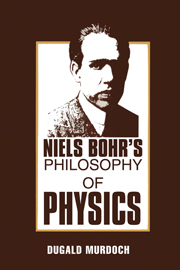Book contents
- Frontmatter
- Contents
- Dedication
- Preface
- Acknowledgements
- 1 Wave-particle duality
- 2 Niels Bohr and wave-particle duality
- 3 From duality to complementarity
- 4 The meaning of complementarity
- 5 The foundations of kinematic-dynamic complementarity
- 6 Bohr's theory of measurement
- 7 Bohr's theory of properties
- 8 Einstein versus Bohr
- 9 The sequel to the Bohr-Einstein debate
- 10 Bohr's philosophy of physics
- 11 An appraisal of Bohr's philosophy of physics
- Notes
- Index
7 - Bohr's theory of properties
Published online by Cambridge University Press: 01 June 2011
- Frontmatter
- Contents
- Dedication
- Preface
- Acknowledgements
- 1 Wave-particle duality
- 2 Niels Bohr and wave-particle duality
- 3 From duality to complementarity
- 4 The meaning of complementarity
- 5 The foundations of kinematic-dynamic complementarity
- 6 Bohr's theory of measurement
- 7 Bohr's theory of properties
- 8 Einstein versus Bohr
- 9 The sequel to the Bohr-Einstein debate
- 10 Bohr's philosophy of physics
- 11 An appraisal of Bohr's philosophy of physics
- Notes
- Index
Summary
In Bohr's view, what ontological significance does measurement have in quantum physics? How, exactly, are we to conceive of the physical properties which we attribute to microphysical objects on the basis of measurement? As we have seen, Bohr regards such properties as objective in the sense that in general they characterise the object immediately before the measurement. But what exactly is their ontological status? In order to answer this question, we shall have to consider in detail Bohr's view of the ontological significance of kinematic-dynamic complementarity. It is generally believed that Bohr held that in quantum physics an object cannot meaningfully be said to possess simultaneously an exact position and an exact momentum. Did he, and if so, why did he?
The interactive-properties theory
Some hold that the process of measurement does not so much create the value of the measured observable as disturb a pre-existing value. On this view the measured value characterises the observable only after the measurement, and not before: the measured value may be said to be a ‘created’ or ‘disturbed’ value.
Bohr, as I have already said, seems to have toyed with this view in his earlier years: even as late as 1933 he says:
Indeed, even in a position or momentum measurement on the electron in a hydrogen atom in a given stationary state one can assert with a certain right that the measuring result is produced only by the measurement itself.
- Type
- Chapter
- Information
- Niels Bohr's Philosophy of Physics , pp. 134 - 154Publisher: Cambridge University PressPrint publication year: 1987



